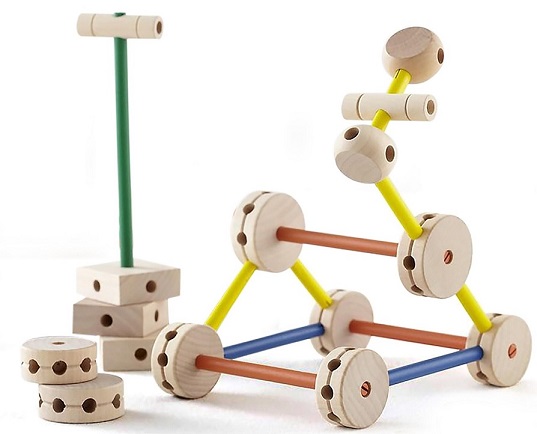
In Germany, toys are not just for fun. They’re tools for thinking.
Open any German toy box and you’re likely to find wooden puzzles, miniature kitchen sets, marble runs, or beautifully crafted figurines made of natural materials. Bright plastic beeping gadgets? Not so much.
German parents and educators tend to see toys not as entertainment, but as instruments of development. The idea that “children learn through play” isn’t just a nice theory – it’s the foundation of how German children grow up.
So what exactly makes a German toy “educational”? And why are Germans so intentional about playtime?
Let’s take a closer look at the purpose, philosophy, and surprising power behind the humble German toy.
The German Approach to Toys: Simplicity, Quality, and Purpose
In many German homes, you’ll notice that children don’t have dozens of toys scattered across the floor. Instead, they often have a small collection of thoughtfully chosen toys, many of which are:
- Made from wood, felt, or fabric
- Free of batteries or screens
- Open-ended in design
- Inspired by real life or nature
- Durable enough to last for years
Why the simplicity?
Because German educational philosophy, especially in early childhood, values self-directed, imaginative, and purposeful play. Rather than overwhelming children with noisy gadgets, parents offer tools that invite creativity, motor development, and problem-solving.
Less Is More: Why Fewer Toys Work Better
A widely discussed German study from the 1990s—“Der Spielzeugfreie Kindergarten” (The Toy-Free Kindergarten) – removed all toys from a preschool for three months. What happened?
- Children became more creative
- They played cooperatively for longer periods
- They invented their own games
- Aggressive behavior decreased
- Attention spans improved
This experiment reinforced what many German parents already believed: children don’t need constant stimulation – they need space to explore their own ideas.
So while many cultures prioritize abundance, German parenting often leans into intentional scarcity: fewer toys, better quality, deeper engagement.
What Makes a Toy “Educational” in Germany?
In Germany, a toy is considered educational if it helps develop one or more of the following:
Cognitive Skills
- Sorting, matching, memory, counting
- Spatial reasoning and pattern recognition
- Language and storytelling skills
Motor Skills
- Stacking blocks, lacing beads, hammering pegs
- Threading, twisting, pouring, shaping
- Fine hand-eye coordination
Imaginative Play
- Role-playing daily life: doctor kits, grocery stands, doll care
- Story creation with animals, figures, or puppets
- Building worlds with open-ended items like cloths, sticks, and boxes
Social Development
- Taking turns
- Inventing shared stories
- Negotiating rules during pretend play
The goal isn’t to “teach” in the classroom sense – but to nurture real-life abilities through meaningful play.
Popular German Toy Brands with a Purpose
Germany is home to some of the world’s most respected toy companies, many of which produce educational toys rooted in traditional craftsmanship and pedagogy.
Here are a few iconic names:
1. HABA
- Known for: wooden baby toys, games, dolls, building blocks
- Philosophy: promote curiosity, logic, and empathy
- Age range: babies to early school age
2. Grimm’s Spiel und Holz Design
- Known for: natural wooden rainbows, stacking arches, tactile shapes
- Philosophy: inspired by Waldorf (Steiner) education, focused on sensory and imaginative play
- Emphasis: open-ended design, beautiful color palettes
3. Selecta
- Known for: rattles, musical toys, and motor skill games
- Highlights: non-toxic paints, FSC-certified wood, Made in Germany
4. Playmobil
- Known for: miniature figures and world-building sets (e.g. farms, hospitals, castles)
- While plastic-based, Playmobil promotes detailed role-playing and storytelling.
5. Ostheimer
- Known for: hand-carved wooden animal and nativity figures
- Philosophy: rooted in Waldorf, designed to leave room for imagination
- Each piece is handmade and painted with care
These brands are not just German exports – they reflect a national educational philosophy about the value of slow, meaningful play.
How German Toys Support the Curriculum
In German preschools (Kindergärten), learning is centered on play – not academics.
There’s no rush to teach reading or math at age four. Instead, teachers focus on:
- Social behavior
- Self-regulation
- Language exposure
- Cooperative play
- Exploration of materials
Toys are not distractions – they are teaching tools.
A basket of wooden animals becomes a story circle. A water table becomes a science lab. A handful of stones turns into a counting game.
This is why the toy selection in German childcare settings is carefully curated – not random or overly commercial.
Toys Without Batteries: A Conscious Choice
You’ll notice that many German toy boxes are free of:
- Flashing lights
- Artificial sounds
- Branded TV characters
- Smartphone apps
This isn’t just nostalgia – it’s intentional.
Research in child development consistently shows that passive toys (those that require the child to do the work) are more beneficial than active toys (those that entertain the child).
In Germany, toys are expected to be:
- Silent (letting the child make the sound)
- Adaptable (used in multiple ways)
- Tactile (engaging multiple senses)
- Durable (to last through many children)
The belief is that children’s minds are the true source of play -not the toy itself.
Cultural Beliefs That Shape German Toy Philosophy
German toy culture is heavily influenced by:
The Waldorf Education Movement
- Founded by Rudolf Steiner in the early 20th century
- Emphasizes rhythm, nature, imagination, and handcrafted materials
- Toys are simple, warm, and open-ended
Montessori Principles (also widespread in Germany)
- Focus on practical life skills and independence
- Toys (called “materials”) are purpose-built and self-correcting
- Children are seen as active learners from birth
Ordnungsliebe (Love of Order)
- German culture values systems, harmony, and clarity – even in play
- Many German toys are beautifully organized and teach sorting, stacking, sequencing, and problem-solving
Together, these influences create a culture in which play is taken seriously – and toys are tools to build both mind and character.
What Expats and Tourists Often Notice
Visitors often find German toy stores refreshingly different. Instead of shelves packed with electronics or tie-ins to TV shows, you’ll find:
- Natural wood and organic fabrics
- Puzzles without cartoon characters
- Toys that feel almost… quiet
- Price tags that reflect quality and longevity
In German homes, playtime often looks slower, more focused, and less frenzied.
It’s not that German kids don’t have fun – they just do it with fewer toys, more freedom, and deeper concentration.
Learning Through Play, the German Way
In Germany, a toy isn’t something that distracts a child. It’s something that awakens them.
It’s a small box of colored beads that teaches patience. A wooden car that drives imagination. A doll made of cloth that becomes a friend.
Through simplicity, quality, and intentional design, German toys help children build the inner scaffolding for creativity, learning, and emotional strength.
Because when play has purpose, learning becomes joyful – and childhood becomes whole.
FAQs: German Educational Toys
What makes a toy “educational” in Germany?
In Germany, an educational toy supports development of motor skills, imagination, cooperation, or problem-solving. It’s usually open-ended and made of natural materials.
Why are so many German toys made of wood?
Wood is durable, tactile, environmentally friendly, and aesthetically pleasing. It supports sensory development and slows play down for deeper engagement.
Are electronic toys common in Germany?
They exist, but they’re not typical in early childhood. German parents often avoid battery-operated toys in favor of those that require active participation.
What are some popular German educational toy brands?
HABA, Grimm’s, Selecta, Ostheimer, and Playmobil are among the most trusted German toy companies.
Continue Exploring the German Family Series:
- Raising Children the German Way: Freedom, Structure, and Forest Schools
- Why German Kids Walk to School Alone: Independence from a Young Age
- The Curious Tradition of Schultüte: Why German Kids Get a Giant Candy Cone
- Birthday Parties in Kindergarten: German Rules Parents Must Follow
- Family Life in Germany: What Makes It So Unique?
- The German Parenting Style: Strict, Structured, and Surprisingly Relaxed







